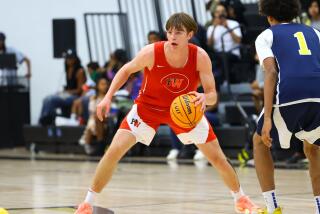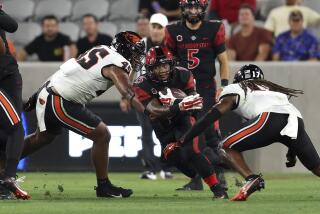Van Breda Kolff Gets to Coast
Jan van Breda Kolff could get used to the anonymity.
The first-year Pepperdine coach was introduced to the sun-baked West Coast Conference on Tuesday in a conference call linking coaches and reporters from Eastern Washington to Southern California.
Van Breda Kolff had to field a grand total of three questions, all softballs. Another coach, Rob Chavez of Portland, wasn’t asked a single question.
Two coaches, Mark Few of Gonzaga and Brad Holland of San Diego, turned the tables on the yawning press by failing to show for their interviews.
For van Breda Kolff, the respite is welcome.
He was harpooned, grilled and left for gristle by the media for six years while coaching Vanderbilt, his alma mater, in the high-profile Southeastern Conference.
By the end, he was labeled as distant and difficult. Pepperdine offered a breath of fresh air as well as a breathtaking view.
In Malibu, van Breda Kolff is free to implement his up-tempo system to eager players without intense scrutiny. And if the quiet of a gym half full of laid-back left coasters bothers him, he hasn’t shown it yet.
“I figure that if we keep winning, the fans will come out,” van Breda Kolff said. “Attendance should pick up for conference games. My primary focus is on preparing the team and winning basketball games.”
The Waves (10-5) open WCC play at home against St. Mary’s (5-8) on Friday night. The premier game that night matches defending champion Gonzaga (10-5) and San Francisco (12-1), winner of 12 consecutive games.
The conference is stronger than usual if comparing scores is an accurate gauge. WCC teams had a nonconference record of 62-47, and their 55 victories over Division I opponents is the highest total in 20 years.
Pepperdine, considered among the weakest WCC teams in a vote of the coaches in October, is held in higher esteem these days. In nonconference games, the Waves displayed athleticism, intelligence and a willingness to throw multiple aggressive defenses at opponents.
The Waves finished last in the conference in free-throw and three-point shooting last season, but are much improved in those areas.
Guards Brandon Armstrong and Craig Lewis are legitimate outside threats, and forwards Tommie Prince, Kelvin Gibbs and David Lalazarian are strong all-around players who can score, run the floor and defend.
Point guard Tezale Archie might be the most pleasant surprise. A fifth-year senior, Archie displays the maturity and leadership to calm the team in close games.
Center Nick Sheppard, also a fifth-year senior, is inconsistent but has contained opposing big men when not in foul trouble. Cedric Suitt, a 6-10 sophomore, is an able backup.
A look at the rest of the WCC:
Gonzaga (10-5): Guard Richie Frahm, the school’s all-time leader in three-point baskets with 233, is one of three returning starters from a team that advanced to the round of eight in the NCAA tournament before losing to eventual champion Connecticut. Frahm averages 17.4 points and is shooting 41% from three-point range. Point guard Matt Santangelo is a four-year starter who needs six assists to break John Stockton’s career school record, and forward Casey Calvary averages 12 points and seven rebounds. Gonzaga, ranked as high as No. 22 this season, has won 15 consecutive games at home. Longtime assistant Mark Few is in his first year as head coach, replacing Dan Monson, who departed for Minnesota.
San Francisco (12-1): Kenyon Jones, a 6-10 senior center, is the most dominant player in the conference. Jones averages 17 points on 65% shooting and eight rebounds. “We’ve never had a dominant inside presence since I’ve been here,” said Coach Phil Mathews, a former Ventura College coach who is in his fifth season at San Francisco. “It’s nice to have somebody we can go to in the post and in the paint.” Freshman Darrell Tucker leads the conference with an 8.2 rebound average. LyRyan Russell is a quick point guard and Ali Thomas is a three-point threat.
Santa Clara (9-6): The Broncos have won four in a row after a sluggish start. Three starters return, but only Nathan Fast, who averages 14.3 points, is playing to his potential. “We are not very good shooters,” Coach Dick Davey said. He was speaking specifically about guard Brian Jones and forward Darrell Teat, who combined to average 28 points last season but are averaging 21 this season.
San Diego (9-4): San Diego’s success is surprising because no player returned who scored in double figures last season. The Toreros get strong production from guards Andre Laws, who averages 13.7 points, and Dana White, who averages 11.5 points and 3.9 assists. Tyler Field, a 6-9 sophomore center, averages 8.1 rebounds.
Portland (6-7): The Pilots play a methodical, half-court game and are capable of pulling off an upset or two. They allow only 61 points a game, second best in the conference. However, they make only 58% of their free throws and 31% of their three-point shots. Sophomore guard Ryan Jones averages 15.4 points.
Saint Mary’s (5-8): Brad Millard, all 7-3 and 345 pounds of him, poses a unique problem for opponents. Millard, who sat out most of the last two seasons because of multiple foot surgeries, averages 15 points and eight rebounds. Frank Allocco, a junior guard, averages 12.9 points but is shooting only 41%.
Loyola Marymount (2-11): The Lions have defeated only Cal Baptist and Occidental. Rupert McClendon is the leading scorer, averaging 11.8 points, and Pablo Machado averages eight rebounds.
More to Read
Go beyond the scoreboard
Get the latest on L.A.'s teams in the daily Sports Report newsletter.
You may occasionally receive promotional content from the Los Angeles Times.











